Yamanote Line
| Yamanote Line | |||
|---|---|---|---|
| JY | |||
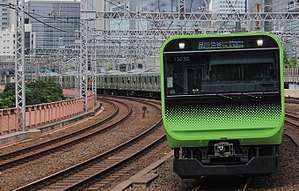 A Yamanote Line E235 series EMU in July 2017 | |||
| Overview | |||
| Native name | 山手線 | ||
| Type | Heavy rail | ||
| Locale | Tokyo | ||
| Termini | Shinagawa (loop) | ||
| Stations | 29 | ||
| Daily ridership | 4,098,582 daily (2015)[1] | ||
| Operation | |||
| Opened | 1885 | ||
| Operator(s) |
| ||
| Depot(s) | Tokyo General Rolling Stock Centre (near Ōsaki Station) | ||
| Rolling stock | E231-500 series, E235 series | ||
| Technical | |||
| Line length | 34.5 km (21.4 mi) | ||
| Number of tracks | 2 | ||
| Track gauge | 1,067 mm (3 ft 6 in) | ||
| Electrification | 1,500 V DC overhead line | ||
| Operating speed | 90 km/h (55 mph) | ||
| |||
The Yamanote Line (山手線 Yamanote-sen) is a railway loop line in Tokyo, Japan, operated by East Japan Railway Company (JR East). It is one of Tokyo's busiest and most important lines, connecting most of Tokyo's major stations and urban centres, including Marunouchi, the Yūrakuchō/Ginza area, Shinagawa, Shibuya, Shinjuku, Ikebukuro and Ueno, with all but two of its 29 stations connecting to other railway or underground (subway) lines.
As an official line name, "Yamanote Line" indicates the tracks between Shinagawa and Tabata via Shinjuku that are used by local trains on their own tracks as well as the parallel Yamanote Freight Line which is used by Saikyō Line and Shōnan-Shinjuku Line trains, some limited express services, and freight trains. However, in everyday usage the "Yamanote Line" refers to the entire 34.5 km loop line served by local trains. (This article uses the same definition unless noted otherwise.)
Service outline
Trains run from 04:26 to 01:18 the next day at intervals as short as 2.5 minutes during peak periods and four minutes at other times. A complete loop takes 59 to 65 minutes. All trains stop at each station. Trains are put into and taken out of service at Ōsaki (which for timetabling purposes is the line's start and terminus) and sometimes Ikebukuro. Certain trains also start from Tamachi in the mornings and end at Shinagawa in the evenings. Trains which run clockwise are known as sotomawari (外回り, "outer circle") and those counter-clockwise as uchi-mawari (内回り, "inner circle"). (Trains travel on the left in Japan, as with road traffic.)
The line also acts as a fare zone destination for JR tickets from locations outside Tokyo, permitting travel to any JR station on or within the loop. This refers to stations on the Yamanote Line as well as the Chūō-Sōbu and Chūō Rapid Lines and between Sendagaya and Ochanomizu.
The line colour used on all rolling stock, station signs and diagrams is JNR Yellow Green No.6 (■, Munsell code 7.5GY 6.5/7.8), known in Japanese as "Japanese bush warbler green" (ウグイス色 uguisu-iro).
Ridership and overcrowding
The ridership of the Yamanote Line in 2015 is 1,097,093 passengers.[1] However, in this case the "Yamanote Line" refers to JR East's internal definition of the entire rail corridor between Shinagawa and Tabata stations via Shinjuku. As such ridership of the local service connecting its 29 stations is divided into several corridors making a complete ridership count of only the Yamanote Loop unavailable. Ridership of the Saikyō and Shōnan–Shinjuku Lines sharing the corridor on the parallel Yamanote freight line is included in the ridership of the Yamanote Line while the ridership of the Yamanote Line between Tabata and Shinagawa Station is excluded and counted as part of the Tōhoku and Tōkaidō Main Lines. Due to the Yamanote Line's central location connecting most of Tokyo's major commuter hubs and commercial areas, the line was very heavily used. Sections of the line were running over 250% capacity in the 1990s and remained above 200% for most of the 2000s.[2][a]
However, with the opening of new alternate railway lines such as the Tokyo Metro Fukutoshin Line with associated through operations and the JR East Ueno–Tokyo Line, overcrowding has been significantly reduced. As of 2016, the busiest section of the line runs at 167% capacity.[3][a]
Name
"Yamanote" literally refers to inland, hillier districts or foothills (as distinct from areas close to the sea). In Tokyo, "Yamanote" lies along the western side of the Yamanote Line loop. The word consists of the Japanese morphemes yama, meaning 'mountain', the genitive suffix no, and te, meaning 'hand', thus literally translating as "mountain's hand", analogous to the English term "foothills".
Yamanote-sen is officially written in Japanese without the kana no (の、ノ), which makes its pronunciation ambiguous in print. The characters 山手 may also be pronounced yamate, as in Yamate-dōri (Yamate Street), which runs parallel to the west side of the Yamanote Line. The Seishin-Yamate Line in Kobe and the Yamate area of Yokohama also use this pronunciation.
After World War II, SCAP ordered all train placards to be romanized, and the Yamanote Line was romanized as "Yamate Line". It was thus alternatively known as "Yamanote" and "Yamate" until 1971, when the Japanese National Railways changed the pronunciation back to "Yamanote". Some older people still refer to the line as the "Yamate Line".
Station list
- Stations are listed in order clockwise from Shinagawa to Tabata, but for operational purposes trains officially start and terminate at Ōsaki.
- Clockwise (外回り sotomawari, "outer circle"): Shinagawa → Shibuya → Shinjuku → Ikebukuro → Tabata → Ueno → Tokyo → Shinagawa
- Counter-clockwise (内回り uchimawari, "inner circle"): Shinagawa → Tokyo → Ueno → Tabata → Ikebukuro → Shinjuku → Shibuya → Shinagawa
- All stations are located in the special wards of Tokyo.
- All trains on the Yamanote Line are local trains that stop at all stations.
- This table also lists stations where Keihin-Tōhoku Line rapid trains would stop.
Legend
- ● : Rapid trains stop
- | : Rapid trains pass
- ▲ : Rapid trains stop only on weekends or holidays
| Line name | No. | Station | Japanese | Distance (km) | Keihin-Tōhoku
Line Rapid |
Transfers | Location | |
|---|---|---|---|---|---|---|---|---|
| Between stations |
Total | |||||||
| Yamanote Line |
SGWJY25 |
Shinagawa | 品川 | from Tamachi 2.2 |
0.0 | ● | Minato | |
OSKJY24 |
Ōsaki | 大崎 | 2.0 | 2.0 | Shinagawa | |||
| JY23 | Gotanda | 五反田 | 0.9 | 2.9 |
| |||
| JY22 | Meguro | 目黒 | 1.2 | 4.1 |
| |||
EBSJY21 |
Ebisu | 恵比寿 | 1.5 | 5.6 |
|
Shibuya | ||
SBYJY20 |
Shibuya | 渋谷 | 1.6 | 7.2 |
| |||
| JY19 | Harajuku | 原宿 | 1.2 | 8.4 |
| |||
| JY18 | Yoyogi | 代々木 | 1.5 | 9.9 |
| |||
SJKJY17 |
Shinjuku[Note 1] | 新宿 | 0.7 | 10.6 |
|
Shinjuku | ||
| JY16 | Shin-Ōkubo | 新大久保 | 1.3 | 11.9 | ||||
| JY15 | Takadanobaba | 高田馬場 | 1.4 | 13.3 |
| |||
| JY14 | Mejiro | 目白 | 0.9 | 14.2 | Toshima | |||
IKBJY13 |
Ikebukuro | 池袋 | 1.2 | 15.4 |
| |||
| JY12 | Ōtsuka | 大塚 | 1.8 | 17.2 | ||||
| JY11 | Sugamo | 巣鴨 | 1.1 | 18.3 | I Toei Mita Line (I-15) | |||
| JY10 | Komagome | 駒込 | 0.7 | 19.0 | N Tokyo Metro Namboku Line (N-14) | |||
| JY09 | Tabata | 田端 | 1.6 | 20.6 | ● | JK Keihin-Tōhoku Line | Kita | |
| Tohoku Main Line | ||||||||
| JY08 | Nishi-Nippori | 西日暮里 | 0.8 | 21.4 | | |
|
Arakawa | |
NPRJY07 |
Nippori | 日暮里 | 0.5 | 21.9 | | |
| ||
| JY06 | Uguisudani | 鶯谷 | 1.1 | 23.0 | | | JK Keihin-Tōhoku Line | Taitō | |
UENJY05 |
Ueno | 上野 | 1.1 | 24.1 | ● |
| ||
| JY04 | Okachimachi | 御徒町 | 0.6 | 24.7 | ▲ |
| ||
AKBJY03 |
Akihabara | 秋葉原 | 1.0 | 25.7 | ● |
|
Chiyoda | |
KNDJY02 |
Kanda | 神田 | 0.7 | 26.4 | ● |
| ||
TYOJY01 |
Tokyo | 東京 | 1.3 | 27.7 | ● |
| ||
| Tokaido Main Line | ||||||||
| JY30 | Yūrakuchō | 有楽町 | 0.8 | 28.5 | | |
| ||
SMBJY29 |
Shimbashi | 新橋 | 1.1 | 29.6 | | |
|
Minato | |
HMCJY28 |
Hamamatsuchō | 浜松町 | 1.2 | 30.8 | ● |
| ||
| JY27 | Tamachi | 田町 | 1.5 | 32.3 | ● |
| ||
| JY26 | Shin-Shinagawa (Provisional) | 品川新駅(仮称) | 1.3 | 33.6 | TBD | Expected to open in 2020 JK Keihin-Tōhoku Line | ||
SGWJY25 |
Shinagawa | 品川 | 0.9 | 34.5 | ● | See above | ||
Rolling stock
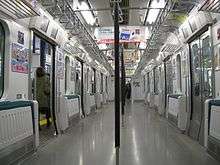
As of October 2016, the line's services are operated exclusively by a fleet of 50 (originally 52 with two transferred to the Chuo Sobu Line[4]) 11-car E231-500 series EMUs, which were phased in from April 21, 2002.[5] These trains originally each included two "six-door cars" with six pairs of doors per side and bench seats that were folded up to provide standing room only during the morning peak until 10 a.m. From February 22, 2010, the seats were no longer folded up during the morning peak,[6] and all trains were standardized with newly built four-door cars by 31 August 2011.[7] This was due to reduced congestion on the line as well as preparation for the installation of platform doors on all stations by 2017.[8]
The E231 series supports a new type of traffic control system, called digital Automatic Train Control (D-ATC), which will help reduce one round trip to a very short 58 minutes. The series also has a more modern design and has two 15-inch LCD monitors above each door, one of which is used for displaying silent commercials, news and weather; and another which is used for displaying information on the next stop (in Japanese, English, Korean and more) along with notification of delays on Shinkansen and other railway lines in the greater Tokyo area. The E231-500 series trains are based at Tokyo General Rolling Stock Centre near Ōsaki Station.[5]
The first of a new fleet of E235 series 11-car EMUs was introduced on the line on 30 November 2015, but a number of technical faults, including problems with door close indicators, resulted in the train being taken out of service the same day.[9] The E235 series returned to service on the Yamanote Line on 7 March 2016.[10] The E235 series trains are intended to ultimately replace the E231 series fleet by 2020.[11]
- A Yamanote Line E231-500 series set in March 2009
 The first Yamanote Line E235 series set undergoing testing in April 2015
The first Yamanote Line E235 series set undergoing testing in April 2015
Former
- DeHo 6100 series (from 1909 until unknown date)
- MoHa 10
- 63 series
- 72 series
- 101 series ("Canary" yellow livery, from September 1961 until circa 1968)[12]
- 103 series ("Uguisu" green livery, from December 1963 until June 26, 1988)[13]
- 205 series (from March 25, 1985 until April 17, 2005)
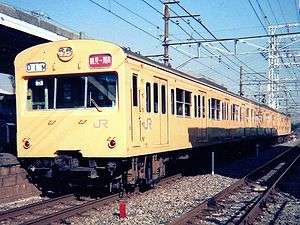 A yellow (Tsurumi Line) 101 series train
A yellow (Tsurumi Line) 101 series train A Yamanote Line 103 series train in March 1985
A Yamanote Line 103 series train in March 1985- A Yamanote Line 205 series train in February 2003
Timeline
Rolling stock transitions since 1960
History

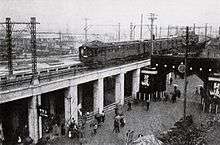
The predecessor of the present-day Yamanote Line was opened on 1 March 1885 by the Nippon Railway Company, operating between Shinagawa Station in the south and Akabane Station in the north.[14] The top part of the loop between Ikebukuro and Tabata (a distance of 3.3 km) opened on 1 April 1903, and both lines were merged to become the Yamanote Line on 12 October 1909.[14]
The line was electrified in 1909, the same year the Osaki – Shinagawa section was double-tracked, with the loop completed in 1925 with the opening of the double track, electrified section between Kanda and Ueno on 1 November, providing a north-south link via Tokyo Station through the city's business centre.[12] A parallel freight line, also completed in 1925, ran along the inner side of the loop between Shinagawa and Tabata.
During the prewar era, the Ministry of Railways did not issue permits to private suburban railway companies for new lines to cross the Yamanote Line from their terminal stations to the central districts of Tokyo, forcing the companies to terminate services at stations on the line. This policy led to the development of new urban centers (新都心、副都心 shintoshin, fukutoshin) around major transfer points on the Yamanote Line, most notably at Shinjuku and Ikebukuro (which are now the two busiest passenger railway stations in the world).
The contemporary Yamanote Line came into being on 19 November 1956 when it was separated from the Keihin-Tōhoku Line and given its own set of tracks along the eastern side of the loop between Shinagawa and Tabata.[12] However, Yamanote Line trains continued to periodically use the Keihin-Tōhoku tracks, particularly on holidays and during off-peak hours, until rapid service trains were introduced on the Keihin-Tōhoku Line in 1988.
A major explosion on the Yamanote Freight Line in Shinjuku in 1967 led to the diversion of freight traffic to the more distant Musashino Line. To address severe undercapacity, the freight line was repurposed for use by Saikyo Line and Shōnan-Shinjuku Line trains, as well as certain limited express trains such as the Narita Express and some liner services. Likewise, from 14 March 2015 onwards, the Ueno-Tokyo Line starts services, which connects the Tohoku Main Line and Joban Line to the Tokaido Main Line, to provide further relief on the busiest portion of the Yamanote Line today, the segment between Ueno and Tokyo stations.
Automatic train control (ATC) was introduced from 6 December 1981, and digital ATC (D-ATC) was introduced from 30 July 2006.[12]
Station numbering was introduced on JR East stations in the Tokyo area from 20 August 2016, with Yamanote Line stations numbered using the prefix "JY".[15]
Future developments
In January 2012, it was announced that a new station would be built on the Yamanote Line and Keihin-Tohoku Line between Shinagawa and Tamachi stations, becoming the first new station on the line since Nishi-Nippori was built in 1971.[16][17] The distance between Shinagawa and Tamachi stations is 2.2 km, making it the longest stretch of track between stations on the Yamanote Line.[16] The new station will be constructed on top of the current 20-hectare railyard which is undergoing rationalization and redevelopment by JR East; it would be roughly parallel to the existing Sengakuji Station on the Toei Asakusa and Keikyu Main lines. The Yamanote Line and the Keihin Tohoku Line tracks will be moved slightly to the east to be aligned closer to the Tokaido Shinkansen tracks. The area on the west side of the yard made available will be redeveloped with high-rise office buildings, creating an international business center with good connections to the Shinkansen and Haneda Airport.[16] The new station is scheduled to open in time for the 2020 Summer Olympics to be held in Tokyo.[18]
See also
- Osaka Loop Line, a similar loop line serving Central Osaka.
- Musashino Line, a line regarded by JR East as part of the Tokyo Mega Loop.
Notes
a. ^ Crowding levels defined by the transport ministry:[19]
100% — Commuters have enough personal space and are able to take a seat or stand while holding onto the straps or hand rails.
150% — Commuters have enough personal space to read a newspaper.
180% — Commuters must fold newspapers to read.
200% — Commuters are pressed against each other in each compartment but can still read small magazines.
250% — Commuters are pressed against each other, unable to move.
References
- 1 2 "平成27年 大都市交通センサス 首都圈報告書" (PDF). P.92. 国土交通省.
- ↑ "JR山手線上野-御徒町間が混雑率ワースト2位に-ワースト1位は総武線". 上野経済新聞 (in Japanese). Retrieved 2017-01-20.
- ↑ "会社要覧 2016-2017" (PDF).
- ↑ JR電車編成表 2011夏 [JR EMU Formations - Summer 2011]. Japan: Kotsu Shimbunsha. May 2010. pp. 74–75. ISBN 978-4-330-21211-1.
- 1 2 JR電車編成表 2015冬 [JR EMU Formations - Winter 2015] (in Japanese). Japan: Kotsu Shimbunsha. 21 November 2014. pp. 76–77. ISBN 978-4-330-51614-1.
- ↑ 山手線6扉車を順次4扉車に [Yamanote Line 6-door cars to be gradually replaced with 4-door cars]. Hobidas (in Japanese). Neko Publishing. 17 February 2010. Retrieved 17 February 2010.
- ↑ 山手線全編成の6扉車置換えが完了 [Yamanote Line 6-door car replacement complete]. Japan Railfan Magazine Online (in Japanese). Japan: Koyusha Co., Ltd. 6 September 2011. Retrieved 6 September 2011.
- ↑ "山手線、朝も全座席使えます 混雑率がちょっぴり改善" [Yamanote Line, seats available mornings too; crowding improved slightly] (in Japanese). 17 February 2010. Archived from the original on 17 February 2010. Retrieved 17 February 2010.
- ↑ 山手線に「次世代通勤電車」 E235系が営業運転を開始 [E235 series "next-generation commuter train" enters service on Yamanote Line]. Chunichi Web (in Japanese). Japan: The Chunichi Shimbun. 30 November 2015. Archived from the original on 8 December 2015. Retrieved 19 February 2016.
- ↑ 山手線 新型車両が3か月ぶりに運転再開 [New Yamanote Line train re-enters service after 3 months]. NHK News Web (in Japanese). Japan: NHK. 7 March 2016. Archived from the original on 7 March 2016. Retrieved 7 March 2016.
- ↑ JR東日本,E235系量産先行車を新造 [JR East to build new E235 series prototype train]. Japan Railfan Magazine Online (in Japanese). Japan: Koyusha Co., Ltd. 2 July 2014. Retrieved 2 July 2014.
- 1 2 3 4 首都圏鉄道完全ガイド 主要JR路線編 [Tokyo Area Complete Railway Guide - Major JR Lines]. Japan: Futabasha. 6 December 2013. p. 13. ISBN 978-4-575-45414-7.
- ↑ Japan Railfan Magazine, October 2008 issue, p.15
- 1 2 Ishino, Tetsu, ed. (1998). 停車場変遷大辞典 国鉄・JR編 [Station Transition Directory - JNR/JR]. I. Japan: JTB. p. 89. ISBN 4-533-02980-9.
- ↑ JR東日本で駅ナンバリングの導入開始 [Station introduced on JR East]. Japan Railfan Magazine Online (in Japanese). Japan: Koyusha Co., Ltd. 21 August 2016. Archived from the original on 1 September 2016. Retrieved 1 September 2016.
- 1 2 3 "New Yamanote Line station eyed". The Japan Times. Kyodo News. 5 January 2012. Retrieved 2014-02-04.
- ↑ Kameda, Masaaki (30 June 2014). "New station to boost Shinagawa's international role". The Japan Times. FYI (column). Retrieved 23 August 2014.
- ↑ 田町~品川駅間に新駅を設置し、まちづくりを進めます [New station to be constructed between Tamachi and Shinagawa] (PDF) (Press release) (in Japanese). East Japan Railway Company. 3 June 2014. Retrieved 4 June 2014.
- ↑ https://www.japantimes.co.jp/news/2017/07/06/national/tokyo-plans-new-effort-ease-crowding-rush-hour-trains/#.Wy4xyadKh3g
Further reading
- Shibata, Togo (December 2016). 山手線の車両史 戦後から今日まで [Yamanote Line rolling stock history since the war until today]. Tetsudo Daiya Joho Magazine (in Japanese). Vol. 45 no. 392. Japan: Kotsu Shimbun. pp. 14–19.
External links
| Wikimedia Commons has media related to Yamanote Line. |
- Stations of the Yamanote Line (JR East) (in Japanese)
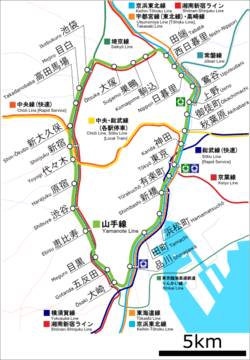
.svg.png)